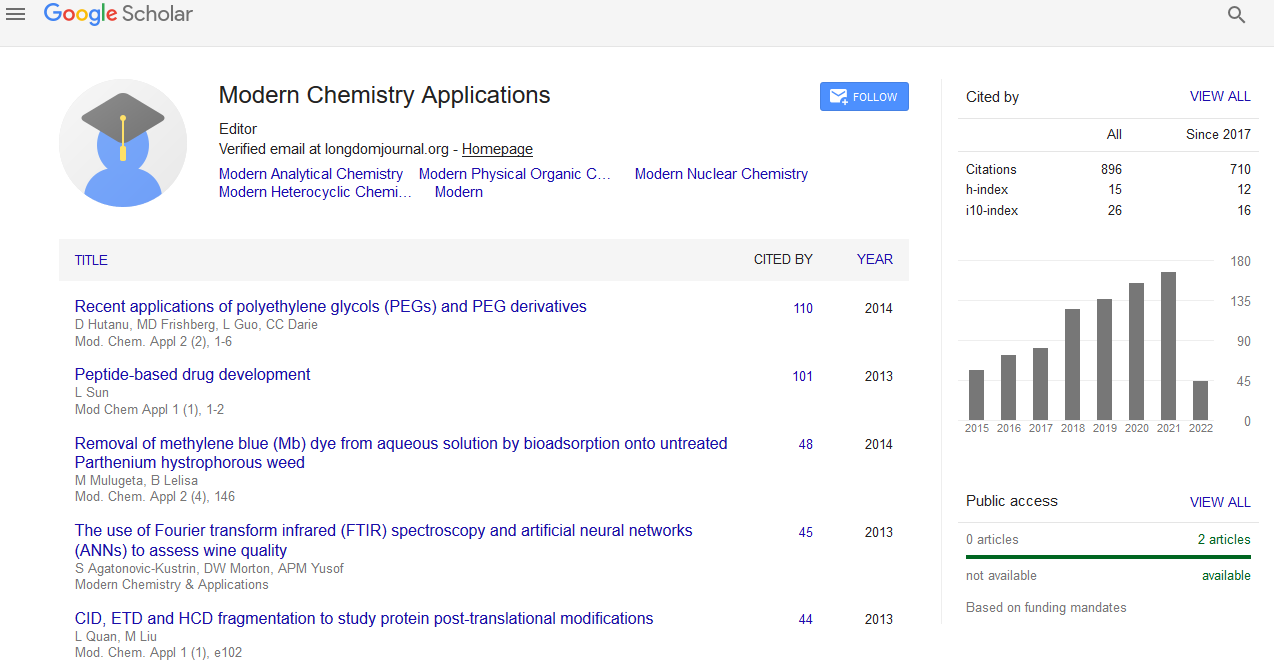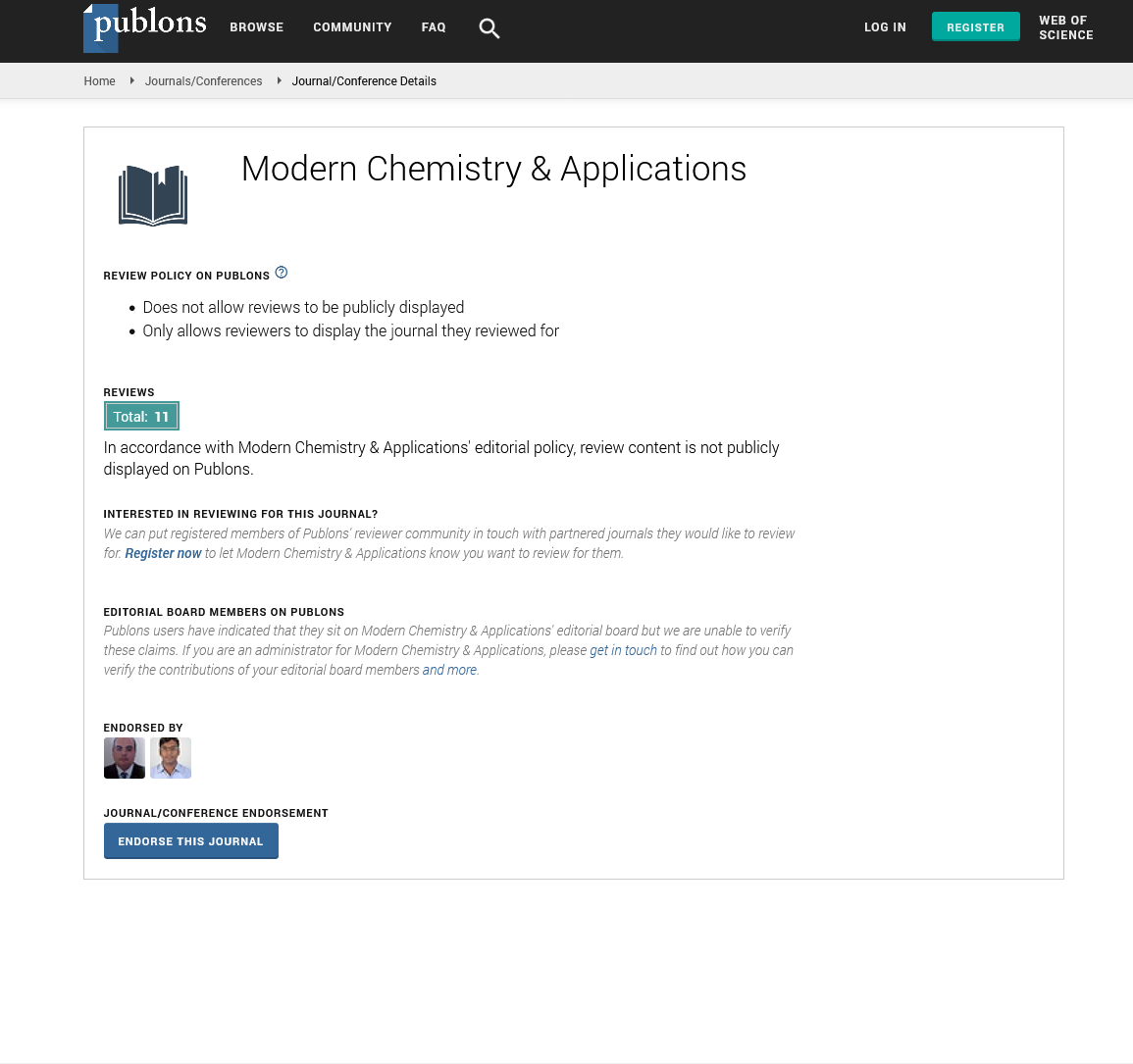Indexed In
- Open J Gate
- JournalTOCs
- RefSeek
- Hamdard University
- EBSCO A-Z
- OCLC- WorldCat
- Scholarsteer
- Publons
- Geneva Foundation for Medical Education and Research
- Google Scholar
Useful Links
Share This Page
Journal Flyer

Open Access Journals
- Agri and Aquaculture
- Biochemistry
- Bioinformatics & Systems Biology
- Business & Management
- Chemistry
- Clinical Sciences
- Engineering
- Food & Nutrition
- General Science
- Genetics & Molecular Biology
- Immunology & Microbiology
- Medical Sciences
- Neuroscience & Psychology
- Nursing & Health Care
- Pharmaceutical Sciences
Short Communication - (2025) Volume 13, Issue 1
Chemical Insights into Atmospheric Processes Impacting Climate, Air Quality, and Human Health
Li Wei*Received: 26-Feb-2025, Manuscript No. MCA-25-29063; Editor assigned: 28-Feb-2025, Pre QC No. MCA-25-29063 (PQ); Reviewed: 14-Mar-2025, QC No. MCA-25-29063; Revised: 21-Mar-2025, Manuscript No. MCA-25-29063 (R); Published: 28-Mar-2025, DOI: 10.35248/2157-7560.25.13.491
Description
Understanding the chemical processes occurring in the atmosphere is essential for addressing challenges related to environmental change, pollution and public health [1]. The atmosphere is a dynamic system composed of gases, aerosols and water vapor, all of which interact through a network of chemical reactions influenced by natural and human-made emissions. These interactions play a major role in determining air composition, climate behavior and exposure risks for populations worldwide [2].
A central component of atmospheric chemistry is the transformation of gases released by natural sources such as oceans, vegetation and volcanic activity, along with those from industrial processes, transportation and agriculture [3]. Once released into the atmosphere, these gases undergo reactions that can either neutralize them or convert them into more reactive or harmful compounds. Sunlight often serves as a trigger for many of these transformations, especially in the formation of pollutants like ground-level ozone and fine particles.
Ozone chemistry in the lower atmosphere has received attention due to its impact on air quality and health. Although ozone is beneficial in the upper atmosphere where it filters harmful ultraviolet radiation, its presence near the surface contributes to respiratory problems and other health concerns [4]. Ozone is not emitted directly but is formed through complex interactions between nitrogen oxides and volatile organic compounds in the presence of sunlight. These reactions can be influenced by temperature, humidity and background pollutant levels, making their behavior difficult to predict without thorough chemical understanding [5].
The interaction between atmospheric chemistry and climate is also an area of intense study. Certain compounds, such as methane and black carbon, have both warming effects and implications for air quality [6]. Methane, for example, not only traps heat but also contributes to ozone production. Aerosols can have opposing effects depending on their composition—some reflect solar radiation and cool the surface, while others absorb heat and contribute to warming. Their influence on cloud formation and precipitation patterns adds another dimension to their impact.
Long-range transport of pollutants means that emissions from one region can affect air quality and weather patterns in distant areas [7]. This has been observed with dust from deserts, smoke from forest fires and industrial emissions. Once airborne, these substances may travel thousands of kilometers before settling, undergoing chemical changes that can modify their impact along the way.
In urban areas, air chemistry is shaped by traffic emissions, industrial activity and heating. These emissions mix with natural compounds and react under sunlight to form smog, a phenomenon often observed in cities worldwide. The chemical reactions involved are influenced by the physical layout of urban environments, meteorological conditions and seasonal variations [8]. Predicting pollution levels requires accurate data on both emissions and chemical reaction rates under varying conditions.
Health impacts related to atmospheric chemistry are of growing concern. Short-term exposure to pollutants such as ozone, nitrogen dioxide and particulate matter can trigger asthma, cardiovascular stress and other acute symptoms. Long-term exposure has been linked to chronic diseases and reduced life expectancy [9]. Research into the chemical composition of air pollutants helps in understanding their toxicological properties and guides regulations aimed at improving air quality.
Improving understanding of atmospheric processes requires collaboration across chemistry, physics, meteorology and public health. Laboratory experiments, field measurements and satellite data are used to track atmospheric composition, while models simulate chemical reactions and pollutant transport on local and global scales. Advances in instrumentation have made it possible to detect trace gases and short-lived species with greater accuracy, aiding in the development of better forecasting tools and environmental policies.
Public awareness and policy decisions also benefit from this scientific knowledge. Regulations on emissions, fuel standards and industrial practices are informed by studies of atmospheric reactions and pollutant effects [10]. As urban populations grow and industrial activities expand, continued research into atmospheric chemistry will be essential for managing climate risks, improving air quality and protecting human health across different regions of the world.
References
- Mir N, Bicer Y Integration of electrodialysis with renewable energy sources for sustainable freshwater production: A review. J Environ Manage. 2021;289:112496.
[Crossref] [Google Scholar] [PubMed]
- Panagopoulos A. Water-energy nexus: desalination technologies and renewable energy sources. Environ Sci Pollut Res Int. 2021;28(17):21009-22.
[Crossref] [Google Scholar] [PubMed]
- Carmona B, Abejón R. Innovative membrane technologies for the treatment of wastewater polluted with heavy metals: perspective of the potential of electrodialysis, membrane distillation, and forward osmosis from a bibliometric analysis. Membranes (Basel). 2023;13(4):385.
[Crossref] [Google Scholar][PubMed]
- Xie M, Shon HK, Gray SR, Elimelech M. Membrane-based processes for wastewater nutrient recovery: Technology, challenges, and future direction. Water Res. 2016;89:210-221.
[Crossref] [Google Scholar] [PubMed]
- Bhatti HJ, Danilovic M. Making the world more sustainable: enabling localized energy generation and distribution on decentralized smart grid systems. World Journal of Engineering and Technology. 2018;6(2):350-82.
[Google Scholar] [PubMed]
- Hossain E, Roy S, Mohammad N, Nawar N, Dipta DR. Metrics and enhancement strategies for grid resilience and reliability during natural disasters. Applied energy. 2021;290:116709.
- Michaels L, Parag Y. Motivations and barriers to integrating ‘prosuming’services into the future decentralized electricity grid: Findings from Israel. Energy Research & Social Science. 2016 Nov 1;21:70-83.
- Dile YT, Karlberg L, Temesgen M, Rockström J. The role of water harvesting to achieve sustainable agricultural intensification and resilience against water related shocks in sub-Saharan Africa. Agriculture, ecosystems & environment. 2013;181:69-79.
[Google Scholar] [PubMed]
- Craddock D. Renewable energy made easy: free energy from solar, wind, hydropower, and other alternative energy sources. Atlantic Publishing Company; 2008.
- Yanine FF, Caballero FI, Sauma EE, Córdova FM. Building sustainable energy systems: Homeostatic control of grid-connected microgrids, as a means to reconcile power supply and energy demand response management. Renewable and Sustainable Energy Reviews. 2014;40:1168-91.
Citation: Wei L (2025). Chemical Insights into Atmospheric Processes Impacting Climate, Air Quality and Human Health. Modern Chem Appl. 13:491.
Copyright: © 2025 Wei L. This is an open access article distributed under the terms of the Creative Commons Attribution License, which permits unrestricted use, distribution and reproduction in any medium, provided the original author and source are credited.


